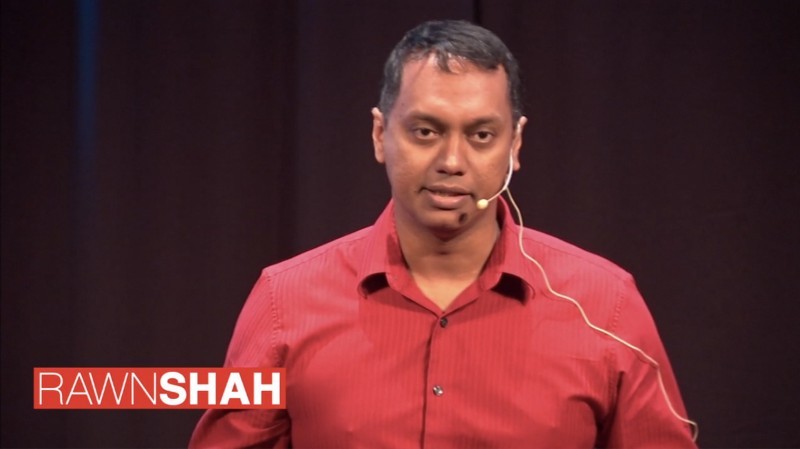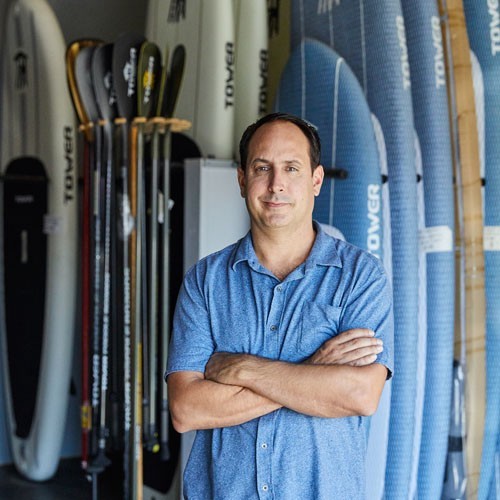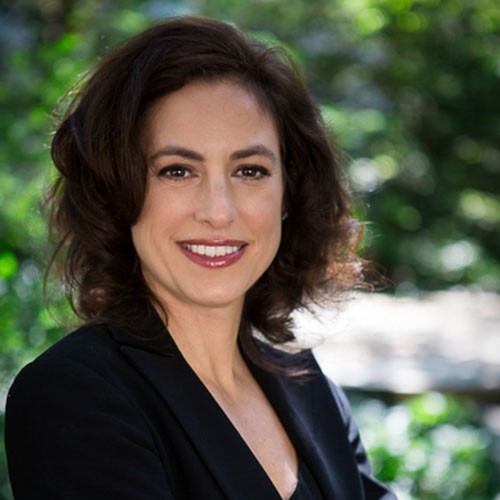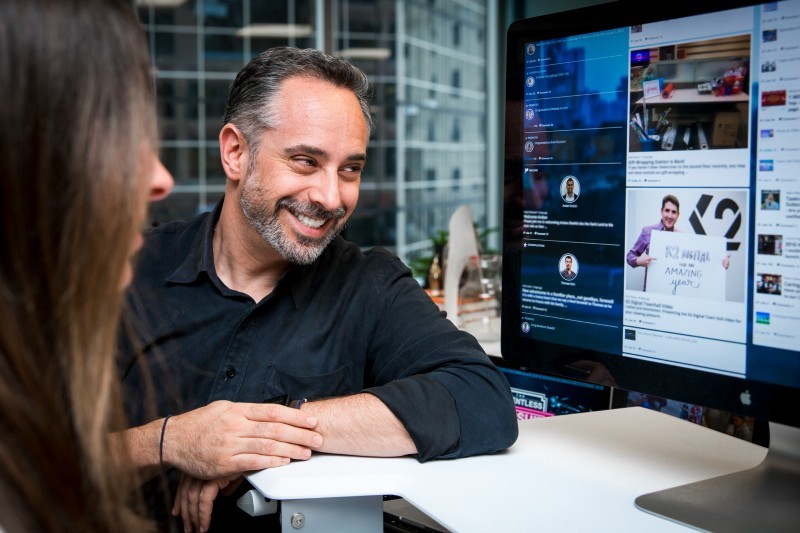Over the last 10 years, companies across the United States and abroad have embraced worker happiness as the №1 driver of productivity. Innovative perks, better benefits and increased flexibility have become essential to any company looking to attract top talent, but the revolution doesn’t stop there. These eight individuals are literally changing the way we work.
Bart Lorang: CEO, FullContact

His Big Idea: Pay Employees to Take Vacation
Lorang, CEO of the cloud-based address book company FullContact, got sick of watching his employees waste their vacations. No sooner had an out-of-office notification gone up than the employee would start responding to emails, burning through precious time off out of fear of missing something back at the office. So Lorang instituted a radical new policy: paying FullContact’s employees to actually go on vacation. “It’s super important for people to disconnect,” Lorang wrote in his announcement of the program, which he illustrated with a picture of himself riding a camel through the Egyptian desert, ignoring the pyramids to check his phone. “It’s so important at FullContact that we will actively incentivize this behavior.”
Each year, FullContact offers a whopping $7,500 stipend with three simple conditions: 1) Go on vacation. 2) Disconnect from the grid. 3) Don’t work a lick.
Unsurprisingly, it’s been a huge hit, and not just with employees. “The benefits have been improved productivity, improved processes, more rested workers and amazing recruiting,” says Lorang. “We have people go all over the world.”
Of course, not every company can afford to pay employees $7,500 not to work, but smaller companies and start-ups can achieve similar results without spending money. “I would just encourage ‘offline time,’” Lorang says, “like weekends where people are off-grid and dinners with spouses where you leave your phones at home! There are lots of small things you can do to try to achieve some digital detox.”
Margaret Heffernan: Author and Professor

Her Big Idea: Get Rid of Job Titles
Margaret Heffernan likes to tell a story about chickens. In a 2015 TED Talk, she spoke about a Purdue University researcher who separated a flock of chickens into two groups: one of average birds and the other composed only of the most competitive, intelligent and productive chickens. After six generations, the average chickens were healthy, plump and producing plenty of eggs, while the flock of superchickens had dwindled to just three birds. They had literally pecked themselves to death.
Heffernan uses this example to illustrate a crucial point: cooperation and competition do not go hand-in-hand. She advocates an end to the traditional corporate hierarchy, or pecking order, starting with the elimination of job titles and ranks. “You take away the status symbols over which people are inclined to compete,” she says. “You motivate people by talking about what they can achieve together.”
Heffernan, who lectures at the University of Bath, says companies that have already followed this example, such as the IT consulting firm Avanade, “are wiser and braver” for doing so. “They recognize that our biggest challenge isn’t under-performance, which is probably a 5 percent problem, but giving people the safety, freedom and trust they need to grow and develop — which is the 95 percent problem. We continue to prioritize obedience over imagination.”
Scott Fleming: CEO, Better Workplace

His Big Idea: Work Where You Please
The importance of a remote workforce is something Scott Fleming understands better than most. As CEO of Better Workplace, he specializes in helping individual companies find out the best way they can let employees start working remotely. Better Workplace’s Workfit software offers companies analytic tools to determine which of their employees might be interested in working off-site. Through a simple survey of a company’s workforce, Workfit can identify people who would be happier and more productive working off-site, and make recommendations to the company to make that dream a reality.
Fleming emphasizes that “mobility is not a one-size-fits-all” solution. “Some employees may not want mobility, or their job is not suited for a mobile work arrangement,” he says. “Workplace mobility is also not about five days per week. Our data shows the average is at approximately 1.5 days per week.” The key is not enacting sweeping change, but taking an up-close look at any company’s workforce and finding the best fit for each individual job.
Rawn Shah: Work Culture Expert

His Big Idea: Micro-Work
One of the major economic changes of the last few years has been the emergence of the “gig economy,” the most extreme expression of which is services like TaskRabbit, where people hire themselves out to do simple tasks, one job at a time. That’s an example of what author and work culture expert Rawn Shah described in a 2015 talk at TEDxBedminster as “the fragmentation of work,” which he believes is the future of personal productivity.
The future of office life, Shah says, is “micro-work,” with companies breaking jobs up into tiny component parts and engaging their employees through an online tasks marketplace similar to TaskRabbit. The most important ingredient? “Teamwork and collaboration.”
“Organizations need to give more flexibility or freedom to employees in their time and selection of work,” says Shah. “A manager still needs commitments from people to dedicate their time to projects, but should allow the possibility that the worker could be involved in other unrelated projects.” In this way, he says, “our potential becomes more about what a person can imagine and try to achieve.”
Stephan Aarstol: CEO & Founder, Tower Paddle Boards

His Big Idea: A Five-Hour Workday
It’s not unheard of for start-up employees to work 50, 60, even 70 hours a week, but that doesn’t mean they have to. Stephen Aarstol is the founder of the fast-growing Tower Paddle Boards. When his company began transitioning out of start-up mode, he noticed an essential aspect of their corporate culture getting lost: fun. Although Tower’s offices were just a block from the beach, his employees never had the time to go outside — so he started sending them home early. He introduced the five-hour workday as a summertime experiment, and Tower never looked back. “The best result of the new program is the psychological mindset shift of the staff,” says Aarstol. “Everyone went from looking at work as this trudge that occupies most of your week, to just this thing we do in the morning that affords us this incredible quality of life.”
By condensing a full day’s work into just five hours, Tower’s employees were forced to eliminate busywork, redundant meetings and time wasted on the Internet. They started getting their work done fast and getting the heck out of there. “We became more productive, not less,” he says. “We also eliminated a lot of wasted time. We were simply getting our work done at a faster pace, and then getting out there and living our life.”
Heidi Brown: Founder and COO, Options Away

Her Big Idea: Keep Mothers in The Workforce
Heidi Brown was born in Canada and spent a decade working in Europe before she moved to the United States. Her whole life, she watched women have children and return to work after a year of paid maternity leave. But when she had two children in the United States, the lack of paid maternity leave forced to her to leave the workforce altogether. She has made it her mission to stop that from happening to other women and believes that all companies could benefit from, as she put it in a recent TEDx talk, “improving the ROI of midcareer female professionals.”
“Every company should make it part of their mission to contribute to women’s advancement,” says Brown, “and start-ups are no exception.” In addition to advocating for better maternity leave, Brown encourages cash-strapped start-ups to look at parents who wish to return to the workforce as an untapped market — a deep pool of experienced, talented workers who prefer part-time, flexible work to a full-time gig. At Options Away, a flight booking service that she founded with her husband after they had children, Brown attracts talented parents by letting them work from home on a regular basis and by offering recruiters a higher fee to place female engineers. “It is fiscally outrageous that so much knowledge, experience, education, talent, etc. is left on the table never to be realized,” she says. “Unless companies begin providing more flexibility to women in and after their childbearing years, this situation will not change.”
Mike Kim: CTO, StrongArm Technologies
His Big Idea: Taking the Weight Off for “Industrial Athletes”
Brooklyn-based manufacturing firm StrongArm Technologies has made it their mission to eliminate workplace back injuries once and for all. Chief Technology Officer Mike Kim worked directly with people who lift for a living — workers StrongArm calls “industrial athletes” — to design a product that would help them distribute weight seamlessly onto their hips, protecting them from the kind of back pain and injury that can end a career. The result was the V22 Ergoskeleton, a futuristic-looking rig which fits snugly around the worker’s body, allowing full range of motion and providing for a 41 percent reduction in stress and fatigue.
“We built the device that the [industry] told us they wanted,” Kim said in an interview with Engineers Rule. “With the V22, you have a full range of motion when you are not lifting something. But as soon as you place your hands under an object, you will engage the clutches and the load will be transferred away from your hands, into the cords, over the shoulders down the spine and to your waist. This will give you the compression where you need it and shift that load away from your hands.” According to Kim, 60 percent of all workers’ compensation claims relate to back injuries, costing the industry over $30 billion a year. The V22 guides a worker into the correct OSHA lifting posture, making even the heaviest load feel manageable — and letting manufacturing workers stay on the job longer and stronger.
Jay Goldman: Co-Author, “The Decoded Company”

His Big Idea: Engineered Ecosystems
Jay Goldman believes the future of the workplace starts with desks on wheels. He first encountered this unusual design choice while profiling Valve Software for “The Decoded Company,” a landmark 2014 book about how big data is changing corporate America. Valve has a completely flat organizational system, with no hierarchy at all, and each team member’s desk has wheels, allowing them to join any project they believe they can add value to. When they’ve done all they can for that project, they join another, or start one of their own.
“Although perhaps too extreme for most organizations,” Goldman says, “Valve’s approach shows the importance in empowering your people to take control of their own destiny and choose a path that rewards them while rewarding the company at the same time.”
The Valve set-up is an example of what Goldman and his co-authors call “an engineered ecosystem,” in which an evolving, organic structure has replaced a traditional top-down hierarchy. Some of Goldman’s other favorite examples of engineered ecosystems include Whole Foods, where their autonomous team structure lets workers respond nimbly to unique problems faced in their store, and the software company Intuit, which developed an in-house brainstorming app designed to let employees bypass the hierarchy to share ideas across departments. In 2017, Goldman envisions the start of a future where employees can jump from project to project, as easily as pushing a desk.
Inspired? Tell us how you’ll be changing work in 2017! Let us know on Facebook and Twitter using the hashtag #Work2017.




Originally published at www.openwork.org.
Originally published at medium.com


